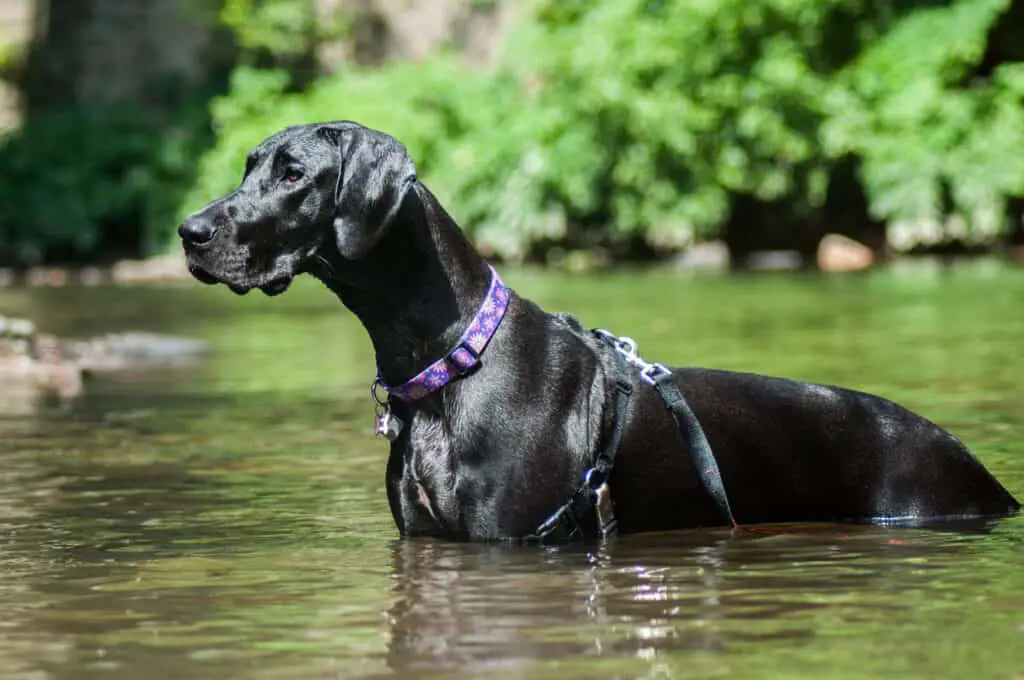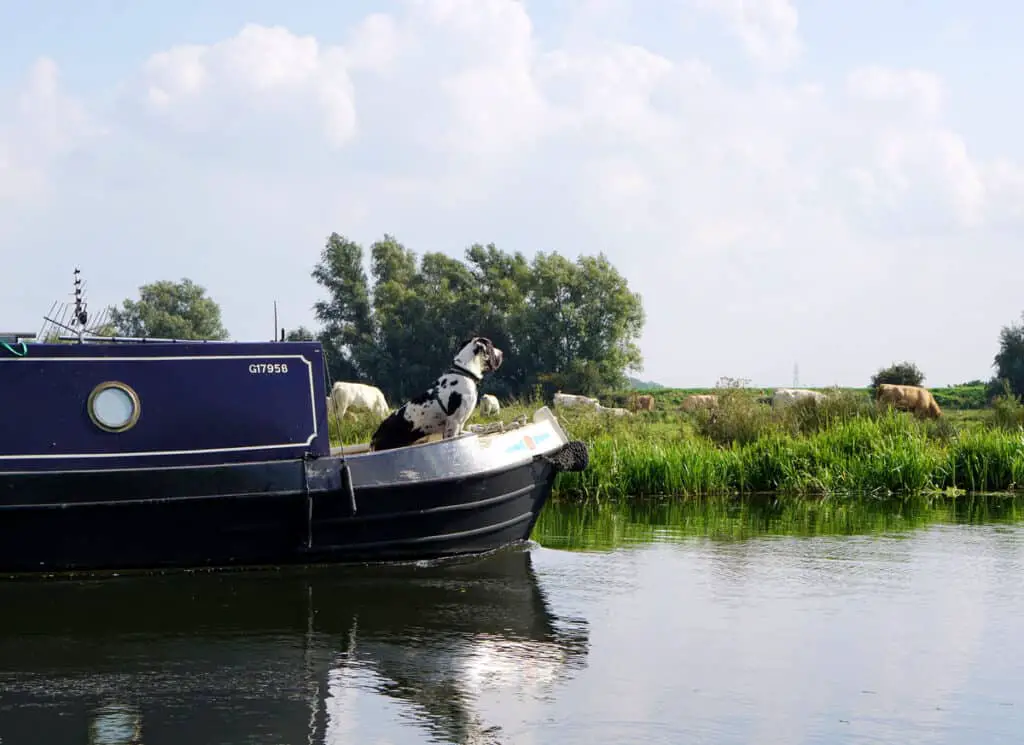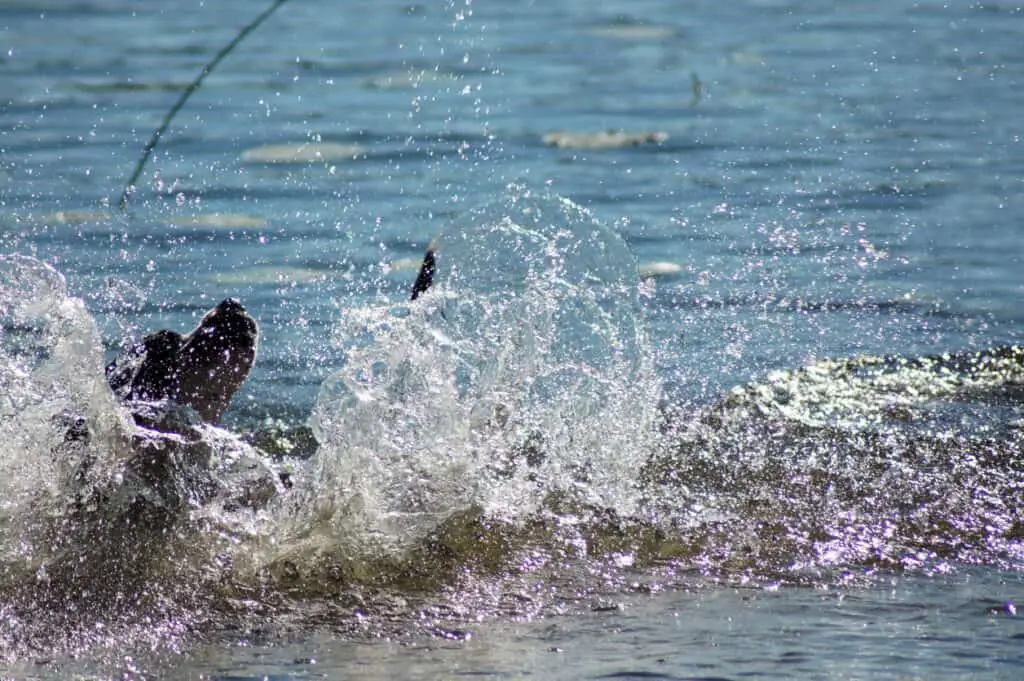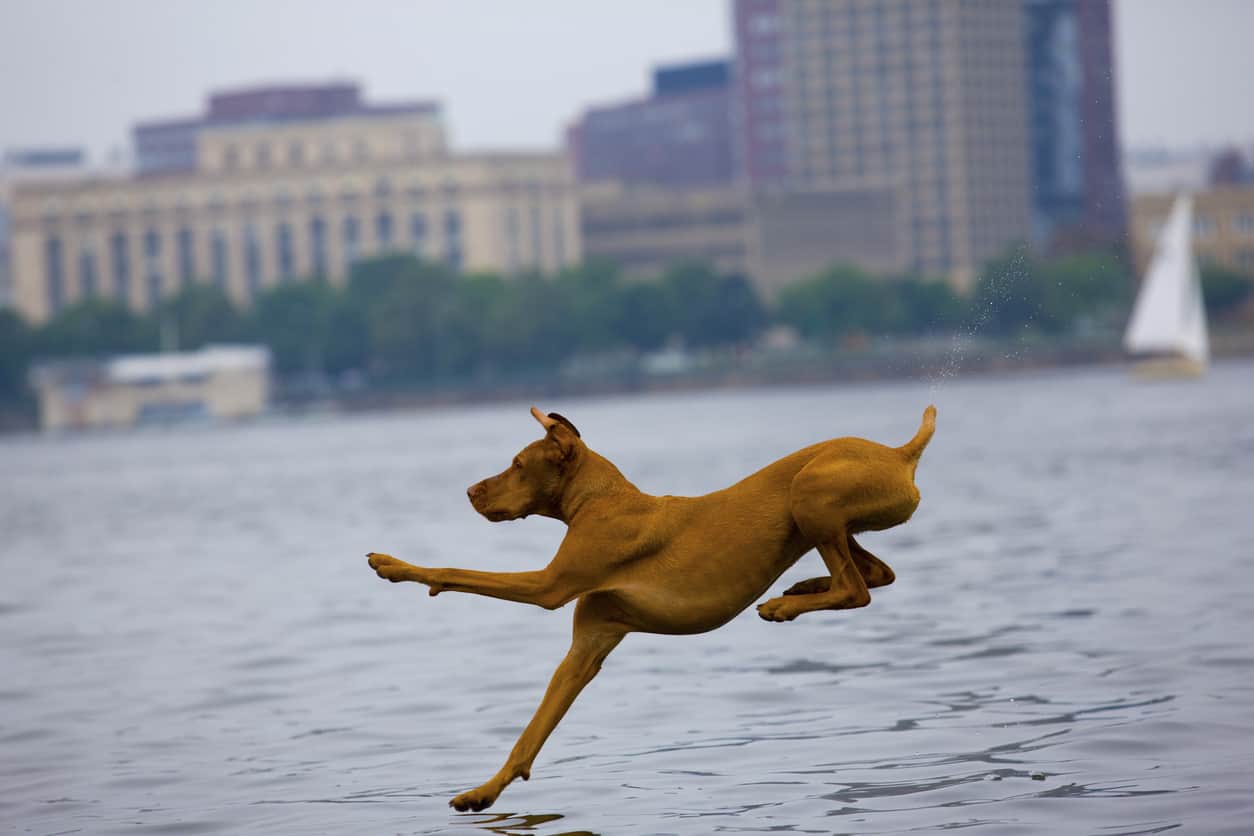Great Danes are not natural swimmers, but this can be easily explained by a brief examination of the breed’s history. Great Danes, also known as German Mastiffs, were originally bred to chase and hold boar on royal hunts through the forests of Germany. Their noble owners would release them onto the scent trail of a boar, and the Great Dane would hold down the animal until the humans arrived and finished off the kill. In this scenario, two of the core traits that the Great Dane is known and beloved for today are visible: its mighty strength and loyal disposition. However, there is a distinct lack of affinity for water in their heritage.

Great Danes are known for being strong and loyal, but they were not bred to swim well.
Tracing the history of a breed is useful because it provides information on its modern-day competencies and predispositions. In this case, Great Danes clearly have no predisposition towards water, however, their build is generally appropriate for swimming, and they can be easily trained to both enjoy water and to swim. This is especially true if they are introduced to water as puppies.
Dog breeds that have a natural predisposition for water are those that have historically been used in capacities involving water. For example, Retriever-types such as the Labrador and Chesapeake adore water, having been bred to charge into ponds and lakes to retrieve felled waterfowl. Other examples include the Newfoundland, Standard Poodle, and water spaniels.
A natural enjoyment of water in these breeds is also supplemented by a physical structure that supports swimming. Unlike Great Danes, which have only a single coat, dogs bred for the water typically have a double coat. A double coat means more shedding in a domestic setting, but in the context of a working or sporting animal, a double coat provides increased insulation and water resistance.
Water dogs also tend to be stocky and strong, with long snouts, webbed feet, and a strong tail that works as a rudder in the water to steady the paddling pooch. While some Great Danes have webbed feet, it’s more of a fun accident when the trait occurs, and their tails are more like whips than rudders. However, Great Danes do have long snouts, strong upper bodies, and long legs for paddling, so their physical makeup makes them strong candidates for learning to swim.
Unlike Great Danes, some breeds cannot swim at all. Breeds that should be carefully monitored around water and prevented from engaging in swimming activity include dogs that tire easily due to the structure of their breathing organs, dogs with short necks and short snouts, and dogs that are not designed to handle cold water conditions. Chief among the breeds that should be prevented from swimming include Pugs, Dachshunds, Basset Hounds, Bulldogs, and Boxers.
Training a Great Dane to enjoy the water

If you’ve welcomed a Great Dane puppy into your home, you can begin introducing it to water as soon as there is occasion to do so. For example, on a hot summer day, you might consider gently spraying your pup with the garden hose, or setting up a kiddie pool for them to splash around in. This will create a low-pressure situation with a high likelihood of fun, that will in turn encourage your Great Dane puppy’s natural sense of adventure and curiosity.
Once your pup is fully vaccinated, you can take them to dog parks and introduce them to any small bodies of water that may be there, such as lakes, ponds, or streams. Taking your Great Dane puppy to dog parks has the added benefit of increasing socialization skills. This is because dog parks draw people and dogs of all dispositions, sizes, and ages. For Great Danes, who have a high need of regular and thorough stimulation, going to a dog park gives them a highly appropriate mental exercise, in addition to the physical exercise that naturally occurs during such an outing.
When introducing a Great Dane puppy to a body of water, it’s important to treat the event as you would if you were introducing a human child to water. You should begin in the shallows, and let the puppy enter the water on its own terms, without dragging it. You might begin by entering the water yourself and encouraging your puppy to follow you, or by tossing a favorite toy where the puppy will have to get wet to retrieve it. In any case, introducing your puppy to water or working on building their confidence is not the time to be dressed in clothes that can’t get wet- your puppy will be looking to you for reassurance and leadership, so be prepared to get a little wet yourself!
These early experiences are crucial because they are forming the foundation of what feelings your Great Dane associates with water. So, making the experience fun and safe is of paramount importance.
Once your puppy is ready to begin swimming, you can lead them into slightly deeper water, using your voice to encourage them. Great Danes will naturally do the infamous “doggie paddle” once they can no longer touch the bottom of a lake, and you will also probably notice a change in their breathing as they begin to swim.
In many cases, a puppy life vest can provide a huge boost of confidence from the very beginning.
A good life vest will have a rescue handle, D-ring, and be bright-colored. You can also purchase a water leash, which can be connected to the D-ring and used to tow your pooch back towards you if you notice that it’s gotten a bit too far away and is becoming tired.
Once your puppy has become a Great Dane that enjoys the water, your main responsibility will be to carefully observe them in the water. This is especially important when play with other dogs is happening because of the increased likelihood that your dog will become exhausted without realizing it.
Signs your Great Dane needs to get out of the water

These signs are very similar to those that tired children in the water will exhibit. Chiefly, if our Great Dane seems to be struggling to keep their head above water, this is one of the main symptoms of exhaustion and distress. Another is whining or looking visibly frightened, such as wide-eyed or panicked. In this situation, you can use your voice to calm your Dane and enact your safety plan for them.
Health risks to Great Danes regarding swimming
One of the greatest health risks facing Great Danes is their tendency to bloat. Bloat, which is when the stomach fills with air of gas and becomes trapped, can be life-threatening and there are many potential triggers. These triggers may include eating too fast, exercising too vigorously or close to eating (before or after), stress, and genes. Because of the range of possible triggers, Great Dane owners need to be especially careful.
When it comes to water, Great Danes should be allowed 2-3 hours to digest their food before being allowed to swim. They should be generally hydrated prior to entering a body of water to lower the likelihood that they consume the water they’re swimming in, which may make them sick. Owners should also take care to check the cleanliness of the water their Dane will be swimming in, as Great Danes have very sensitive stomachs in general and unclean water may make them ill.
The benefits of introducing your Great Dane to water
Water provides an excellent way for Great Danes to increase the scope of their familiarity with the world, and an outlet for socializing them with other dogs and people. Socialization is extremely important for this breed, which has natural guard dog tendencies. This means that they can become nervous or suspicious quickly if they encounter situations that they’re not familiar with, meaning it’s important to constantly contrive ways of introducing Great Danes to new situations.
Additionally, although it’s best and arguably easier to introduce a Great Dane puppy to water compared to an adult, there’s no reason not to try with an adult Dane. It just may take more patience and persuasion. For example, if your adult Great Dane is suspicious and fearful of water, it can be considered a “win” if you successfully walk it through the shallows of a small lake. The important thing is to create positive associations, and not to push too much too fast before the animal is ready.
As with all animals, body language will tell you a lot about what your Great Dane is thinking. If they are shrinking from the water or reluctant to so much as put a paw in, it may be time to take whatever final small victory you can take before engaging them in a situation with which they feel more confident. By being able to accurately gauge and respond to your Great Dane’s body language, you are also reassuring it of your ability to care for it and address its needs, which will pay dividends in later exercises involving water and your bond in general.
Other ways for your Great Dane to continue to enjoy the water even without swimming
If your Great Dane is going to spend the day near water, but you know they’re not interested in playing in it, you can still make the situation enjoyable for them! For example, you could purchase an inflatable life raft and encourage them to clamber up on it – no swimming required! Additionally, laying out a nice blanket nearby all the action lets the dog decide – maybe your pooch will want to come over and see what all the hubbub is about with water, after all! Finally, one of the most controlled settings that you can create to encourage your Great Dane to investigate and become comfortable with water is that of the kiddie pool. On a hot day, fill the kiddie pool with water and encourage your Great Dane to investigate – they’ll likely soon realize that the cold is worth the splash!
Key takeaways Although Great Danes are not natural swimmers, they are plenty trainable in this aspect. There are certain considerations to keep in mind (chiefly, the risk of bloat as it pertains to vigorous exercise too soon before or after eating a meal), but by taking precautions such as monitoring their feeding schedule and equipping your Dane with a life vest and other protective swimming equipment, you can make swimming a fun and safe activity for your gentle giant.


